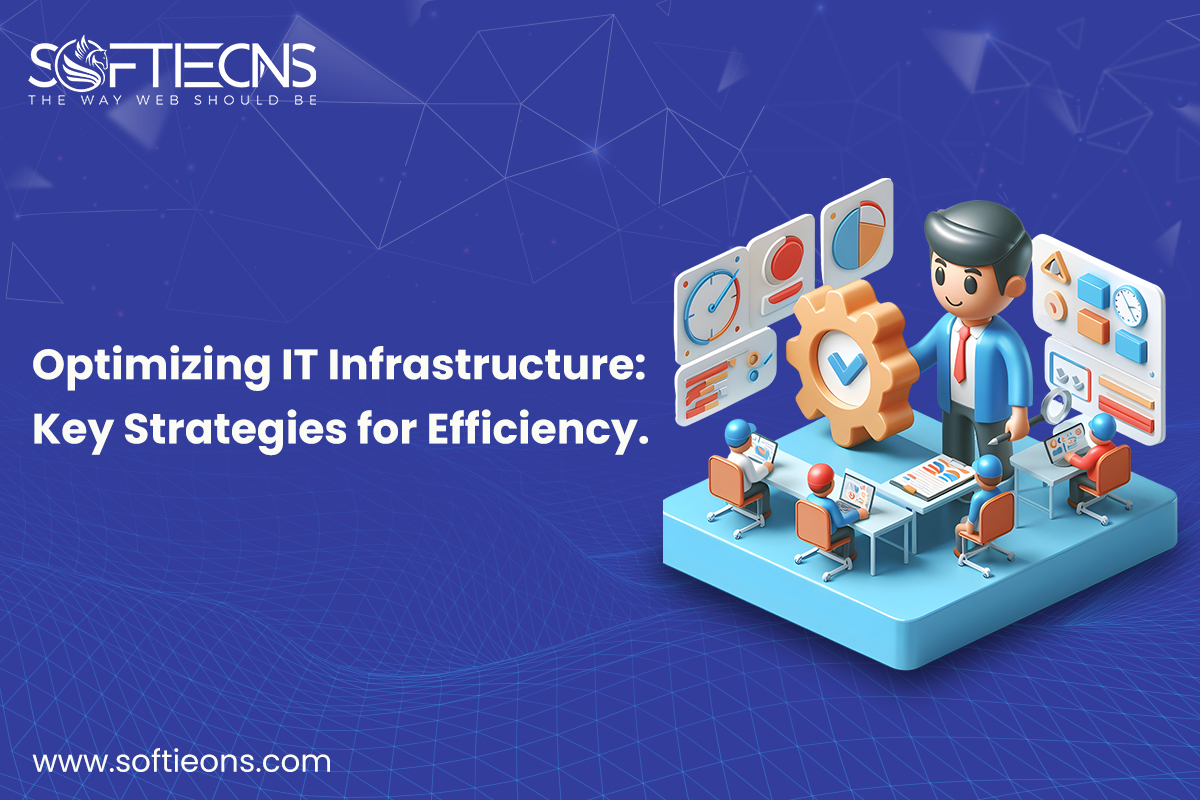Optimizing IT Infrastructure: Key Strategies for Efficiency
Mon, 13 May 2024
Businesses are constantly seeking ways to enhance productivity and maintain a competitive edge in today's fast-paced digital landscape. One key area where significant improvements can be made is streamlining IT processes. Optimizing your IT infrastructure can lead to cost savings, increased productivity, and enhanced overall performance.
In this blog article, we'll explore several important techniques for optimizing your IT infrastructure and simplifying operations. Efficiency is crucial in the rapidly evolving world of technology, and it's essential to leverage IT infrastructure for maximum productivity and cost-effectiveness. From automation tools to cloud computing solutions, we'll cover everything you need to know to propel your business forward. Let's dive in and discover how you can optimize your IT systems to drive success and innovation.
Introduction to IT Infrastructure and its Importance in Business Operations
In today's digital era, information technology (IT) plays a critical role across all aspects of business operations. IT infrastructure is the foundation that ensures smooth and optimized processes, enabling efficient handling of client data and fostering collaboration among staff members.
So, what exactly is IT infrastructure? It encompasses the hardware, software, networks, and services necessary to support an organization's entire IT ecosystem. This includes everything from computers and servers to databases and cloud computing solutions. A robust IT infrastructure is essential for businesses to meet evolving demands and manage complex operations effectively. Without it, organizations would struggle to adapt and thrive in today's dynamic business environment.
Importance of IT Infrastructure in Business Operations:
Promotes Collaboration: An effective IT infrastructure fosters seamless communication among stakeholders within a company. Through tools like instant messaging, video conferencing, and email, employees can connect and collaborate regardless of their location or time zone, enhancing project coordination and overall productivity.
Enhances Security Measures: In today's digital landscape, where cyber threats are prevalent, a strong IT infrastructure is essential for ensuring data security. Robust security systems, including firewalls and encryption methods, protect sensitive information from potential breaches.
Streamlines Business Operations: By leveraging appropriate hardware and software solutions, organizations can automate various business processes such as accounting and inventory management. This automation saves time and reduces the risk of human error, improving operational efficiency.
Improves Customer Service: A robust IT infrastructure enables quick access to customer data and facilitates efficient communication between customers and businesses. This enhanced connectivity and information accessibility contribute to improved customer service and satisfaction.
Enables Scalability: As businesses grow, their technological needs evolve. An IT infrastructure designed for scalability allows companies to expand without facing limitations imposed by technology constraints, supporting sustained growth and development.
Conclusion:
Businesses must have an optimal IT infrastructure to remain competitive in the fast-paced world of today. It simplifies processes and makes it possible for businesses to develop and change in response to the rapidly changing technological environment. We'll go over several important tactics for IT infrastructure optimization in the next part, which may aid companies in more effectively achieving their operational objectives.
Critical Approaches to Enhance IT Infrastructure Efficiency:
In today's fast-paced business landscape, the success of any organization hinges on having a streamlined and efficient IT infrastructure. A well-managed IT setup not only saves costs but also enhances productivity and overall operational effectiveness. However, keeping up with evolving technology and rising expectations can pose challenges for maintaining an effective and modern IT environment.
To navigate this landscape successfully, here are key strategies to ensure the efficiency and smooth operation of your IT infrastructure:
Assess Your Current Infrastructure: Begin by conducting a comprehensive evaluation of your existing setup to identify any redundant or inefficient components that could be impeding operations. Understanding your current infrastructure thoroughly is crucial before making any modifications.
Embrace Cloud Computing: Leveraging cloud computing is a highly effective approach to streamline your IT environment. By transitioning some or all of your applications and data storage to the cloud, you can reduce hardware costs significantly while gaining flexibility and scalability for future growth.
3. Standardize Hardware and Software: Several departments employ disparate hardware and software systems in their businesses, which causes incompatibilities and higher maintenance expenses. You may solve these issues and streamline administration by standardizing hardware and software throughout the company.
4. Make Use of Virtualization Technology: This technique lowers hardware costs and improves resource efficiency by enabling the operation of numerous operating systems on a single physical server. The ease of backing up and restoring virtual computers makes disaster recovery planning much easier.
5. Use automation tools: Time-consuming manual processes like software updates and security patch management take up significant time for IT personnel. These repetitive jobs may be finished rapidly without human involvement by using automation techniques, freeing up time for more important work.
6. Invest in Remote Monitoring Systems: Proactive maintenance and spotting any issues before they worsen depend on keeping an eye on the condition of your network and IT equipment. Purchasing remote monitoring solutions can assist you in monitoring the functionality of your network and promptly resolving any problems.
7. Consider outsourcing: Engaging a specialized service provider for specific IT tasks like support or maintenance can reduce costs and enhance productivity. This approach allows your internal IT team to focus on strategic business goals by delegating routine tasks to external experts.
You may save expenses, increase overall operational efficiency, and simplify your IT infrastructure by putting these important methods into practice. Reassess your infrastructure regularly and upgrade it as needed to keep it optimum for your company's evolving demands.
Automation and Standardization of Processes
Automation and standardization are two key components of streamlining any organization's operations; these are especially true when it comes to IT infrastructure optimization. These strategies involve implementing rules and guidelines that eliminate manual labor and promote consistency in the process. Automation streamlines tasks, minimizing errors and freeing up staff for higher-value work, enhancing efficiency.
Organizations may optimize their processes by utilizing software tools and apps to set up automatic triggers that start operations depending on certain events or circumstances. This guarantees that procedures are carried out consistently with little delays or mistakes in addition to saving time.
Furthermore, automation helps businesses save expenses in a big way. The firm can save money since fewer human resources are needed when automated technologies take the place of manual work. Moreover, companies may maximize resource allocation and raise overall productivity by automating processes to streamline operations.
Conversely, standardization refers to the implementation of consistent and efficient processes and procedures throughout an organization's activities. It includes establishing precise roles and duties within teams, establishing benchmarks for quality control procedures, and guaranteeing adherence to legal and regulatory requirements.
Enhanced team communication is one of the main advantages of standardizing procedures. A common knowledge of expectations is created when everyone adheres to established protocols, which improves teamwork. Workflows become more efficient as a consequence, and the likelihood of misunderstandings or miscommunications is decreased.
Additionally, standardization fosters scalability by enabling businesses to duplicate effective procedures across divisions or regions without constantly having to start from scratch. This guarantees uniform service delivery throughout the company while also saving time.
Additionally, uniformity helps with risk management. Organizations can detect possible risks and put preventative measures in place by putting established processes and procedures in place. Implementing cloud services reduces the risk of errors or failures that could disrupt operations.
Standardization and automation play key roles in optimizing IT infrastructure and streamlining workflows. They help a business save costs while simultaneously enhancing production, efficiency, and risk management. Businesses may maintain their competitiveness in the quickly changing business environment of today by adopting these tactics.
- Making Use of Cloud Services
An effective and optimized IT infrastructure is now essential for corporate success as technology develops and organizations depend more and more on digital activities. Using cloud services is a crucial tactic in doing this.
Cloud services refer to the delivery of computing resources via the internet, granting businesses access to various applications, storage, and processing power on demand. This model offers flexibility and scalability, reducing costs and eliminating the need for costly hardware and software purchases.
One significant advantage of cloud services is cost savings. Unlike traditional IT setups that require investments in expensive hardware like servers and storage, cloud services provide these resources at a lower cost. This allows businesses to leverage advanced technology while reallocating funds to other critical expenses.
Another benefit is increased agility. Today's competitive business environment demands rapid adaptation and responsiveness to change. Cloud services enable organizations to quickly deploy and scale resources, empowering them to stay agile and competitive in dynamic markets.
This agility is provided by cloud services, which let companies scale up or down their processing power as needed without experiencing any hardware outages or additional costs. This makes it possible for businesses to smoothly handle sporadic variations in demand or unexpected surges in demand without affecting business as usual.
Additionally, utilizing cloud services helps improve departmental and team cooperation.
Utilizing a centralized platform for storing information and applications, accessible from anywhere with the internet, fosters seamless collaboration among employees regardless of location. This boosts creativity, productivity, and efficiency within organizations.
Security is another vital aspect of IT infrastructure optimization. Cloud service providers offer advanced security measures, updated regularly to counter potential threats. They also provide disaster recovery capabilities, protecting against data loss from cyberattacks or natural disasters. Many smaller businesses would struggle to afford these features if managing their IT infrastructure.
Cloud services are pivotal for improving IT infrastructure and streamlining operations. They offer cost savings, increased agility, enhanced collaboration, and robust security, ultimately driving productivity and profitability. Investing in cloud services is essential to stay competitive and future-proof operations amid rapid technological advancements
- Applying Technology for Virtualization
Virtualization technology revolutionizes IT infrastructure by replacing physical hardware, software, and storage with virtual resources. This boosts operational flexibility, efficiency, and performance while reducing costs. It's a crucial method for enhancing IT infrastructure and maximizing business outcomes. Using this method, companies may construct several virtual machines (VMs) on a single physical server and combine their hardware resources. It is feasible to execute several workloads concurrently and without interruption thanks to these virtual machines (VMs), which function as independent operating systems with their suite of apps.
There are several advantages to using virtualization technology. First of all, allowing companies to operate several virtual machines (VMs) on a single server rather than requiring separate servers for every job, helps them to maximize their hardware usage. Energy use, equipment charges, and maintenance costs all decrease as a result of this.
Furthermore, by eliminating the need for extra physical servers, virtualization improves scalability by facilitating the rapid and easy creation of new virtual machines (VMs). This gives companies the flexibility they need to adjust to shifting business requirements and seamlessly manage peak workloads.
Enhanced disaster recovery capabilities are an additional benefit of virtualization technology use. Compared to conventional backup techniques, virtual machines (VMs) provide significantly faster and more effective system failure recovery since they are simply files that can be duplicated or backed up onto external drives or cloud-based platforms.
Apart from these advantages, centralizing administration responsibilities into a single dashboard or interface is another way that virtualization makes management chores easier. This eliminates the need for IT staff to visit each physical server individually and allows them to effectively monitor and administer every virtual machine (VM) from a single place.
However, it's important to remember that careful preparation and thought are necessary for the successful application of virtualization technologies. Companies need to evaluate their existing infrastructure and identify the workloads that would be most suited for virtualization. They also need to take into account things like performance effects, compatibility with current systems, and security.
A critical first step in improving IT infrastructure and simplifying operations is the implementation of virtualization technologies. Businesses may benefit from cost savings, scalability, enhanced disaster recovery capabilities, streamlined administration chores, and many other advantages. Organizations may profit from this technology and get a competitive edge in the rapidly evolving digital world of today by properly designing and deploying it.
- Consistent upkeep and improvements
Optimizing your IT infrastructure requires regular updates and maintenance. Your systems may become unstable and inefficient without regular maintenance, which might disrupt operations and pose security threats. We will talk about the value of routine maintenance and updates in this part to streamline operations.
First of all, routine maintenance assists in locating and resolving minor concerns before they become significant ones. Routine maintenance on network, hardware, and software components can help you detect possible issues or vulnerabilities early on. In the long term, this preventive strategy saves time and costs by averting expensive downtime or data loss.
Furthermore, scheduled upgrades guarantee that your systems remain current with the newest developments in technology. Outdated software or hardware can impede productivity and slow down operations. Investing in emerging technologies or upgrading to newer versions might offer better security measures, quicker processing rates, and more usefulness.
Regular updates and maintenance not only improve performance but also assist with regulatory needs. Strict laws governing data security and privacy apply to many businesses. You may guarantee adherence to these requirements by maintaining your systems with care and updates.
Regular maintenance also increases the longevity of your IT infrastructure, which is a benefit. Like an automobile that requires routine oil changes to be in good working order, IT systems too require upgrades to stay in good working order. Ignoring maintenance chores might cause software malfunctions or early device failure that necessitate expensive emergency repairs.
Furthermore, you can maintain your competitiveness in a corporate environment that is always changing with updates and ongoing enhancements. Companies need to stay up to date with industry trends to fulfill client requests and stay relevant, as new technologies are emerging at a rapid rate.
To put into practice efficient routine maintenance protocols for your IT infrastructure:
1) Establish a schedule: Decide on a regular timetable for routinely checking all hardware—servers, storage units, routers, etc.—as well as software upgrades.
2) Set priorities for important areas: Determine which important areas, including performance and security, need more regular upkeep.
3) Make use of automation tools: These can assist reduce the time and error-proneness of maintenance procedures by streamlining them.
4) Speak with IT specialists: Consulting with IT specialists may assist you in identifying any problems and choosing the best course of action for infrastructure maintenance.
Updating and maintaining your IT infrastructure regularly are crucial tactics for infrastructure optimization. You may guarantee efficient operations, regulatory compliance, longer system lifespans, and enhanced competitive advantage by giving these duties priority.
- Contracting Out Non-Core IT Work
Many companies are choosing to strategically outsource non-core IT functions to improve their IT infrastructure and simplify their operations. Businesses that outsource may concentrate on their key skills while leaving non-essential work to be completed by other professionals. Significant cost savings, increased effectiveness, and greater performance are possible outcomes of this.
Cost savings is one of the key advantages of outsourcing non-core IT work. It can be costly to hire and educate staff members for specialized IT duties, particularly if those duties are unrelated to the main goals of the business.
Through outsourcing, companies may only pay for the services they want and don't have to worry about other expenses like software and hardware maintenance fees, staff benefits, or training costs. By doing this, important resources are freed up to be used in other crucial parts of the company.
Additionally, outsourcing non-core IT duties contributes to increased operational effectiveness. Businesses may anticipate quicker response times and higher-quality outcomes by assigning these responsibilities to specialized service providers with in-depth expertise in their respective sectors. These service providers offer effective solutions that support the objectives of the business by utilizing state-of-the-art technology and industry best practices.
The availability of specialist knowledge is an additional benefit of outsourcing non-core IT duties. Most businesses lack the funds and manpower to employ full-time experts to handle every facet of their IT requirements. However, by contracting out particular tasks like data management or cybersecurity, companies may access highly qualified experts with specialized knowledge that might not be present in-house.
Furthermore, operations may be made more flexible and scalable by outsourcing. An organization may need more assistance from its IT infrastructure as it expands or faces demand swings. Businesses may swiftly scale up or down through outsourcing since they don't have to worry about the fixed expenses of maintaining an internal staff.
By reducing the amount of time spent on non-core IT management, firms can focus on creating growth- and innovation-oriented initiatives. Optimizing operations to maximize resource usage is crucial for accomplishing corporate goals and gaining a competitive edge in the marketplace.
Businesses aiming to improve their IT infrastructure and simplify their operations can reap substantial benefits from outsourcing non-core IT functions. It enables businesses to acquire specialist knowledge, cut expenses, increase efficiency, foster flexibility and scalability, and concentrate on their core skills. In today's fast-paced digital world, organizations may achieve better levels of efficiency and success by utilizing external workers for non-essential IT jobs.
Case Studies: Productive IT Infrastructure Optimization in Real-World Examples
Case studies are a potent tool for demonstrating how IT infrastructure optimization techniques work in actual situations. These illustrations offer verifiable proof of how companies have been able to optimize their IT infrastructure and achieve notable operational gains.
A prominent retail firm is the subject of one such case study. The company was experiencing frequent outages and sluggish system performance, which led to lost sales and unhappy consumers. The core problem was found by the company's IT staff to be an antiquated and disjointed architecture, with several legacy systems and apps operating on several platforms.
The business put in place a thorough plan for optimizing its IT infrastructure to deal with this problem, which included virtualizing apps, consolidating servers, and deploying cloud-based services. They were able to cut downtime by 70% by centralizing their systems and optimizing their workflow, which raised output and enhanced customer satisfaction.
Another illustration is a banking organization that was having issues with data security because of its dispersed network architecture. The company has several branches, each with its own set of servers and data storage equipment, dispersed among several places. This made it difficult to properly monitor and safeguard critical client data.
The financial institution used network segmentation strategies in conjunction with a hybrid cloud approach to address this obstacle. As a result, they were able to consolidate their data storage while maintaining the separation of vital and non-critical systems. They were able to lower the expenses of maintaining several physical infrastructures and improve data security as a consequence.
In each of these situations, businesses were able to maximize the use of contemporary technology like network segmentation, cloud computing, and virtualization to improve their IT infrastructure. This not only resulted in cost savings but also considerably increased overall business efficiency.
These fruitful case studies also demonstrate how, in addition to providing technological advancements, an efficient IT infrastructure can help organizations achieve their objectives. For example, more efficient operations may lead to more effective resource allocation, enabling companies to concentrate on innovation instead of upkeep.
Case studies are used to demonstrate the efficacy of IT infrastructure optimization techniques. Businesses may get insights into the difficulties and the advantages of putting in place an efficient IT infrastructure by studying these real-world examples.
Making investments in IT infrastructure optimization may pay off handsomely in terms of lower costs, higher output, and happier customers.
Assessing the Efficiency of Streamlined Processes
Assessing the efficacy of optimized processes is crucial for any enterprise seeking to maximize its information technology setup. It is impossible to say whether or not the modifications made to simplify operations have been beneficial without appropriate assessment and analysis.
Establishing precise objectives is the first step in gauging the success of simplified operations. These objectives have to be quantifiable and in line with the organization's overarching aims. For instance, within six months, a target can be to cut the time it takes to respond to consumer questions by half.
Key performance indicators (KPIs) should be established once the goals have been determined to monitor the goals' progress. KPIs might include measures like cost reductions, productivity gains, and customer satisfaction scores, but they can also vary based on your company's needs and the particular objectives you have established.
Proper data-gathering procedures must be in place to measure KPIs accurately. This might entail putting in place new software or systems that can monitor pertinent data points like website traffic, sales figures, or worker productivity. It could also entail asking consumers for their opinions or conducting surveys.
It is essential to routinely examine and evaluate this data to comprehend how simplified activities affect the IT infrastructure of your company. One way to find out if there has been any gain in efficiency or cost savings using streamlining tactics is to compare current data with baseline measures made before applying the strategies.
Getting input from staff members who are actively involved in daily operations is another crucial component of assessing effectiveness. They may point up any areas that need development and offer insightful information on how effectively the optimized procedures are functioning.
Additionally, when you've implemented streamlining tactics, asking clients for feedback may yield a wealth of information about their interactions with your business. This may be used to determine whether higher customer satisfaction is the result of more effective procedures.
It is crucial to remember that assessing efficacy shouldn't be a one-time thing but rather a continuous activity. It's critical to routinely assess and modify goals and KPIs in light of how company demands and technology are changing.
Assessing the efficacy of efficient operations is crucial to maximize an enterprise's information technology setup. Organizations may precisely gauge the effects of streamlining techniques on their operations by defining clear objectives, creating pertinent KPIs, gathering and evaluating data, and getting input from staff members and clients.
In conclusion
Businesses must optimize their IT infrastructure to increase productivity and flexibility in the quickly changing digital environment. Organizations may achieve smooth scaling, enhanced performance, and streamlined operations by incorporating critical tactics including cloud-native architectures, intelligent orchestration, and improved automation.
Looking ahead, cutting-edge technologies like edge computing, 5G networks, AI, and machine learning will influence IT infrastructure optimization in the future. Predictive maintenance, real-time processing at the edge, and improved security measures to safeguard data in decentralized contexts will all be made possible by these technologies.
In the end, IT infrastructure optimization is about giving organizations the tools they need to remain robust, competitive, and nimble in an increasingly digital environment. It's not just about technology. Through the use of these tactics and the adjustment to emerging patterns, enterprises may utilize their IT infrastructure as a tactical advantage to propel expansion and novelty.
POPULAR POSTS
Shopify vs. WordPress: Which one is best for e-commerce?
Wed, 07 Apr 2021Role of IoT in the Real Estate Industry
Wed, 14 Apr 2021Why UX And UI Is Important For Mobile Application Development
Sat, 01 May 2021Telemedicine's Advantages in Nursing Homes
Fri, 24 Dec 2021RECENT POSTS
Title: Run Your Entire Real Estate Business From Your Phone
Fri, 12 Dec 2025









